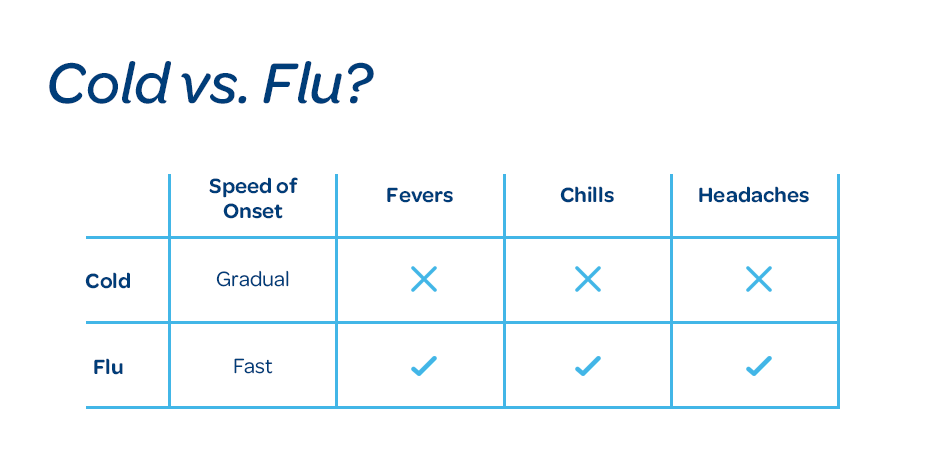What’s the Difference Between Colds and Flus?
A little information can help you get on the road to feeling better.
When the flu is going around and you or a loved one starts feeling under the weather, it can be tough to tell if you have the flu or are fighting off a nasty cold. Unfortunately, it can be hard to tell the two apart for sure. They share a number of symptoms and both leave you feeling crummy.
The good news is that there are differences between the two, and a little information can help you get on the road to feeling better.
Colds and flus, where do they come from?
Both colds and flus are respiratory illnesses that are caused by viruses and spread by coughs and sneezes. The difference is that cold-causing viruses are far more diverse and less severe than flu-causing viruses.
Type of Cold Viruses
Rhinoviruses
This virus type, also called human rhinoviruses (HVRs), causes about 50% of all colds in people. There are more than 100 strains of HVR. They are able to adapt very easily and unexpectedly, which makes them tough to avoid.
Other Cold Viruses
There are too many to name here—more than 200 that we know of! The important thing to note is that cold-causing viruses are far more diverse than flu causing viruses, which is why there is no “cure for the common cold” or vaccines against colds.
Types of Flu Viruses
Influenza A
The source of most flus, often the most dangerous ones that cause pandemics (sudden, widespread outbreaks). Influenza A viruses can be carried by people and a number of animals. This makes them very diverse and tough for medical professionals to plan for with flu vaccines. Remember the “swine flu” in 2009? That was from an Influenza A virus (H1N1) that was previously only common in pigs.
Influenza B
Only found in humans, influenza B viruses are less common and generally less severe—but it may be hard to believe that if you are the one affected. That said, they can still cause pandemics and should be taken seriously. Infections with this type of flu are more prevalent in the tail end of the flu season.
Influenza C
Like B, Influenza C only affects people, but it is less severe and is not capable of causing pandemics. We do not routinely test for Influenza C.
Influenza D
This type of flu virus only affects cattle, so unless you’re a farmer with some cow friends you care about, you don’t need to worry about Influenza D.bout Influenza D.
Colds and flus, how to know which is which?
Both can cause sore throats, stuffy or runny noses, chest congestion, coughs, and make you feel tired, which is why it’s so difficult to tell them apart. But luckily, there are some differences that can help give you a clue.
If I’m worried about getting sick, or am sick but unsure of what I have, what should I do?
First of all, get a flu vaccine every year! Although they may not protect you against every type of flu virus, they are the best first line of defense against getting the flu. So even if you get the flu, it should be over much more quickly and will help you avoid serious complications like pneumonia.
If you’re sick or worried that a loved one might have the flu, come in and be seen early! We can assess your symptoms, take a thorough history—including sick contacts—and perform a physical exam. If your provider finds it helpful, they may perform a rapid flu test—although this is not required for diagnosis or treatment.
The sooner you are seen, the better, considering the medications that are used to treat the flu should be started within the first 48 hours of symptom onset to be effective. These medications are the best prevention for more serious complications, especially in high-risk populations such as the very young, very old, those with compromised immune systems, and those with chronic diseases of the lungs




